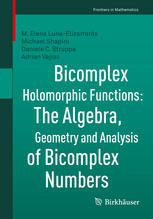

Most ebook files are in PDF format, so you can easily read them using various software such as Foxit Reader or directly on the Google Chrome browser.
Some ebook files are released by publishers in other formats such as .awz, .mobi, .epub, .fb2, etc. You may need to install specific software to read these formats on mobile/PC, such as Calibre.
Please read the tutorial at this link: https://ebookbell.com/faq
We offer FREE conversion to the popular formats you request; however, this may take some time. Therefore, right after payment, please email us, and we will try to provide the service as quickly as possible.
For some exceptional file formats or broken links (if any), please refrain from opening any disputes. Instead, email us first, and we will try to assist within a maximum of 6 hours.
EbookBell Team

4.1
30 reviewsThe purpose of this book is to develop the foundations of the theory of holomorphicity on the ring of bicomplex numbers. Accordingly, the main focus is on expressing the similarities with, and differences from, the classical theory of one complex variable. The result is an elementary yet comprehensive introduction to the algebra, geometry and analysis of bicomplex numbers.
Around the middle of the nineteenth century, several mathematicians (the best known being Sir William Hamilton and Arthur Cayley) became interested in studying number systems that extended the field of complex numbers. Hamilton famously introduced the quaternions, a skew field in real-dimension four, while almost simultaneously James Cockle introduced a commutative four-dimensional real algebra, which was rediscovered in 1892 by Corrado Segre, who referred to his elements as bicomplex numbers. The advantages of commutativity were accompanied by the introduction of zero divisors, something that for a while dampened interest in this subject. In recent years, due largely to the work of G.B. Price, there has been a resurgence of interest in the study of these numbers and, more importantly, in the study of functions defined on the ring of bicomplex numbers, which mimic the behavior of holomorphic functions of a complex variable.
While the algebra of bicomplex numbers is a four-dimensional real algebra, it is useful to think of it as a “complexification” of the field of complex
numbers; from this perspective, the bicomplex algebra possesses the properties of a one-dimensional theory inside four real dimensions. Its rich analysis and innovative geometry provide new ideas and potential applications in relativity and quantum mechanics alike.The book will appeal to researchers in the fields of complex, hypercomplex and functional analysis, as well as undergraduate and graduate students with an interest in one- or multidimensional complex analysis.